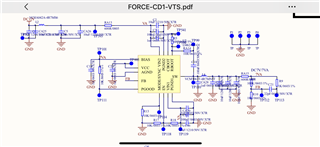Hi Sir,
To improve EMC products,
They connected a 10 ohm resistor between R boot and SW of lm62440-q1 chip,
And the SW pin is directly connected to the ground and has a 10pF capacitor,
In addition, a 4.7 ohm resistor is connected in series between C boot and R boot.
Does the above affect the circuit function?
R5 = 4.7 Ω, ra14 = 10 Ω, ca28 has been changed from 1NF to 10PF.
The problem now is that when the customer's products fluctuate at low pressure (3V − 9V),
The chip temperature is very high, and there is a chance of short circuit. After changing R5 to 0 Ω, the temperature is normal,
However, we are not sure about the impact of ra14 and ca28 on the design, so we would like to hear your suggestions.

Thanks.


